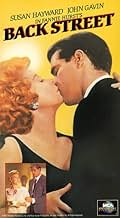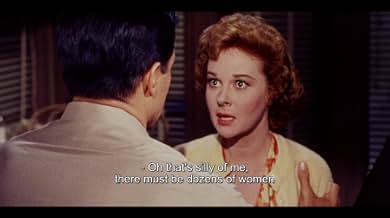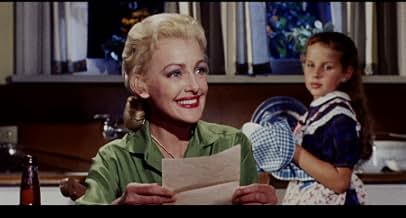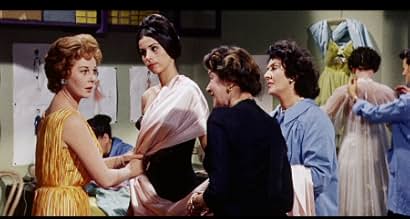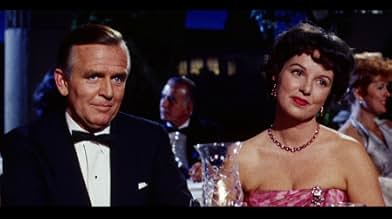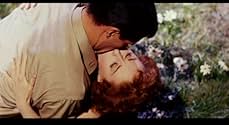NOTE IMDb
6,6/10
1,4 k
MA NOTE
L'histoire d'amour entre l'ambitieuse Rae Smith et l'élégant Paul Saxon débute au moment où celui-ci part à la guerre. Elle durera plusieurs années.L'histoire d'amour entre l'ambitieuse Rae Smith et l'élégant Paul Saxon débute au moment où celui-ci part à la guerre. Elle durera plusieurs années.L'histoire d'amour entre l'ambitieuse Rae Smith et l'élégant Paul Saxon débute au moment où celui-ci part à la guerre. Elle durera plusieurs années.
- Réalisation
- Scénario
- Casting principal
- Nommé pour 1 Oscar
- 1 nomination au total
Joseph Cronin
- Airport Clerk
- (as Joe Cronin)
Avis à la une
I feel a great affinity with Back Street because of the way it shows that a love affair will stay exciting and endure longer because the lovers are only able to be together for short periods of time with long intervals between their meetings. The hum drum aspects of married life never changes their relationship. They are on a perpetual honeymoon. Every time they meet it is exciting and they always look forward to seeing each other. I have often thought that if I had never married my husband and just had a relationship with him like Susan Hayward had with John Gavin over the years I probably would have been happier. She had the best of both possible worlds in my estimation. A wonderful successful career and the knowledge that someone loved her passionately and completely all those years. In addition she could return that love without reservation and enjoy the happiness it gave her to do so. I bet there are thousands of married women who watched this movie and had the same thoughts as I.
Even in 1961, this had to be taken as a parody of the plush, woman's picture genre. The story had already been filmed in 1932 and 1941, and was creaky by any standard. All the deluxe Ross Hunter trappings (gowns by Jean Louis, jewels by Alexandre) are even more inflated here, with Hayward's gowns designed to match the drapes in the background. The overblown extravagance of the whole production makes Hunter's epics with Lana Turner look like second-string, double feature fare. Oscar-winner Hayward began her descent into strictly camp territory with this warhorse of a soaper; 1963's "Stolen Hours" (a remake of the Bette Davis classic, "Dark Victory") and 1964's "Where Love Has Gone" (co-starring Davis!) continued the trend, until it culminated in Hayward's (indeed, the world's) pinnacle of trash, "Valley of the Dolls" (1967). But back to "Back Street." The well-worn story concerns Hayward, an impossibly chic fashion designer, who is in love with the impossibly handsome (and improbably wooden) John Gavin, a married department store heir. Gavin's wife happens to be rip-roaring alcoholic Vera Miles, who is prone to falling down drunk at parties and threatening suicide. Hayward is nobly self-sacrificing, content to be the "back street" woman for the sake of Gavin's children (who are played by utterly resistible tots). That is, until Miles becomes one of Hayward's couture clients! This is the kind of loopy film where Hayward goes from being a scrappy little dressmaker to world famous couturier in, oh, ten minutes; where elaborate scenes are set up solely to showcase Jean Louis' scrumptious creations (they have no plot bearing whatsoever); and where John Gavin is somehow allowed to play his Really! Big! Scene! as if he's had a full frontal lobotomy (of course, he's so damned gorgeous, you really don't care). Oddly enough, Miles walks off with the film--her teeth are so firmly set into the scenery, you couldn't remove her if you tried, unless you wanted to pull back a bloody stump. (Lana Turner would never have let a supporting player upstage her show!) Hayward clearly took note to never let that happen again, and would give nothing but nostril-flaring, eye-bugging performances for the balance of her career. Look also for Natalie "Lovey Howell" Moorehead in a small but hilarious role as one of Hayward's gossipy clients. As swoony as all this is, "Back Street" is perfect lowbrow entertainment with highbrow trappings, and a sad reminder that, once upon a time, Hollywood DID make stuff like this--when even "bad" movies at least had a healthy shot of glamour to make them enjoyable.
Try to understand that 1961 was the dawn of the sexual revolution predicated on the birth control pill; therefore everything in this movie reflects the pre-1961 era when people were often locked into marriages -- good or bad.
This glamorized version opens the story up from simple people in the 1932 and 1941 versions and makes them self-assured, very good-looking, and easy-street rich. This allows the cameras to give us beautiful vistas of Rome, Paris and London --- as they were before the Great Tourist Invasion which began in 1965 when Pan American World Airways broke with the IATA cartel and slashed fares to Europe, allowing folks like us to join the rich and go there. Now I can tell you that Susan Hayward's Paris hotel was definitely the RITZ -- the Rue Cambon entrance -- the back street entrance near the Ritz Bar where Hemingway evicted a rich woman's pet lion by throwing said lion out on the sidewalk.
Under David Miller's able direction, the narrative is kept solid; even though it's hard to find sympathy for the romantic problems of two persons who otherwise have it all.
Not available on DVD, you can find a VHS on eBay; but it won't be cheap.
This glamorized version opens the story up from simple people in the 1932 and 1941 versions and makes them self-assured, very good-looking, and easy-street rich. This allows the cameras to give us beautiful vistas of Rome, Paris and London --- as they were before the Great Tourist Invasion which began in 1965 when Pan American World Airways broke with the IATA cartel and slashed fares to Europe, allowing folks like us to join the rich and go there. Now I can tell you that Susan Hayward's Paris hotel was definitely the RITZ -- the Rue Cambon entrance -- the back street entrance near the Ritz Bar where Hemingway evicted a rich woman's pet lion by throwing said lion out on the sidewalk.
Under David Miller's able direction, the narrative is kept solid; even though it's hard to find sympathy for the romantic problems of two persons who otherwise have it all.
Not available on DVD, you can find a VHS on eBay; but it won't be cheap.
I have watched this film probably more than a dozen times and finally purchased the DVD even though it was only available in full TV-Sized screen format. It may be low brow and poor in most respects for a movie critic's standards, but I love it. I did not think either Hayward or Gavin did a bad or wooden job with their performances. Maybe I am just a patsy for tear-jerker style movies, but I have always enjoyed this movie, even today when it appears so dated and somewhat impoverished by today's standards of movie making. Perhaps we have become too jaded and so-called sophisticated to just sit back and appreciate a story that is reasonably well told and beautifully filmed.
When first released some forty years ago, critics rightly complained about the soap-opera plot, the melodramatic dialog, the stock characters, and the excessive showcasing of sets and costumes. These complaints are still valid, but over the course of four decades, a realization has emerged that despite or even because of these failings, "Back Street" is a gloriously entertaining work that plays just as well now as it did back in 1961. How many other movies can claim this sort of durability? I would, however, like to point out five faults in the production. (1) Susan Hayward is a good ten or even fifteen years too old for this part. (2) The film's supposed message about the emptiness of being the "other woman" is blunted by the opulent success in which Hayward lives. (3) Vera Miles' character is so selfish and shrewish that one can't imagine why John Gavin ever married her. There should have been a line about how he'd been forced into an "arranged" marriage in order to save the family business. (4) When Gavin and Hayward meet for the first time in New York, after their initial encounter in Nebraska, he seems surprised to learn that she's now the famous fashion-designer who signs her creations "rae" -- all small letters, very chic -- even though she'd specifically told him of her plans at their first meeting. How many fashion-designers named "rae" did he think there were in the world? (5) One must wait more than forty minutes before Gavin takes his shirt off, and then he just has a dimly-lit scene where he and Hayward run out of the ocean in modest swim-wear before reclining on a beach towel. Gavin's physique deserved much more exposure than this.
Le saviez-vous
- AnecdotesA clip of Rae saying goodbye to Paul the marine is featured at the beginning of Stevie Wonder's "Part-Time Lover" music video as a couple watches "Back Street" on TV.
- GaffesAfter Rae's confrontation with Paul's son, she drives out to the country house and turns off the paved road onto a dirt road. But, in the next shot, the rear-screen projection still shows the paved road.
- Citations
Paul Saxon: [presenting her with a framed portrait of himself] Do you think you can build a room around that?
Rae Smith: Why not? I've built a life around it.
- ConnexionsFeatured in The Universal Story (1996)
- Bandes originalesSymphony No. 4 in E minor I. Allegro non troppo
Composed by Johannes Brahms
Meilleurs choix
Connectez-vous pour évaluer et suivre la liste de favoris afin de recevoir des recommandations personnalisées
- How long is Back Street?Alimenté par Alexa
Détails
- Durée
- 1h 47min(107 min)
- Rapport de forme
- 1.85 : 1
Contribuer à cette page
Suggérer une modification ou ajouter du contenu manquant

